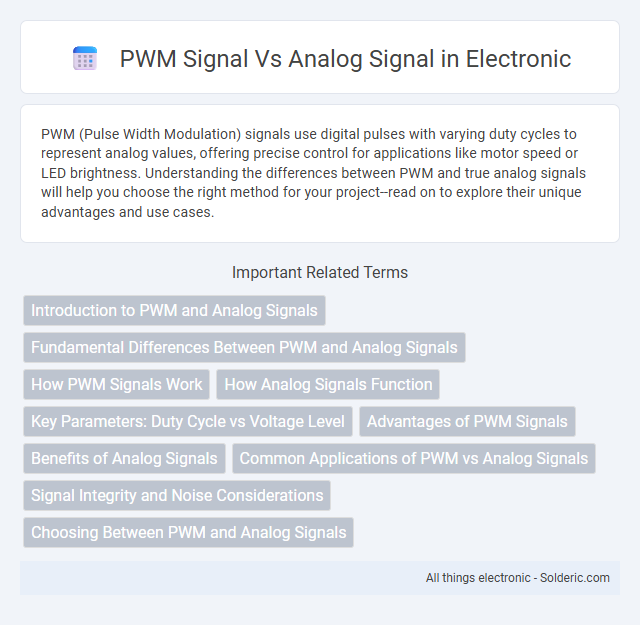PWM (Pulse Width Modulation) signals use digital pulses with varying duty cycles to represent analog values, offering precise control for applications like motor speed or LED brightness. Understanding the differences between PWM and true analog signals will help you choose the right method for your project--read on to explore their unique advantages and use cases.
Comparison Table
| Feature | PWM Signal | Analog Signal |
|---|---|---|
| Definition | Pulse Width Modulation; digital pulses with variable duty cycle | Continuous electrical signal varying smoothly over time |
| Signal Type | Digital (binary on/off) | Continuous (voltage or current levels) |
| Control Method | Modulates pulse duration at fixed frequency | Directly varies voltage or current amplitude |
| Noise Immunity | High; digital nature resists interference | Lower; susceptible to noise and distortion |
| Power Efficiency | High; switches fully on/off, reducing losses | Lower; dissipates power linearly in analog components |
| Complexity | Requires digital circuitry for generation and decoding | Requires analog circuitry for generation and processing |
| Applications | Motor control, LED dimming, communications | Audio, sensors output, instrumentation |
| Signal Representation | Duty cycle percentage represents analog value | Voltage/current magnitude represents signal value |
| Bandwidth | Limited by switching frequency | Wide bandwidth, continuous spectrum |
Introduction to PWM and Analog Signals
PWM (Pulse Width Modulation) signals encode information by varying the pulse duration within a fixed frequency, enabling efficient digital control of power delivery and motor speed. Analog signals vary continuously over time, representing information through voltage or current levels corresponding to physical phenomena. Your choice between PWM and analog signals depends on the required precision, noise tolerance, and application in electronic control systems.
Fundamental Differences Between PWM and Analog Signals
PWM signals represent information through varying pulse widths in a fixed frequency digital wave, while analog signals convey data via continuous voltage levels. PWM encodes signal amplitude by adjusting duty cycle percentages, providing efficient control in digital systems. Analog signals, conversely, offer smooth, infinite amplitude variations but are more susceptible to noise and distortion in transmission.
How PWM Signals Work
PWM signals work by rapidly switching a digital signal between on and off states, controlling the power delivered to a device by varying the duty cycle--the percentage of time the signal is high within each cycle. Unlike analog signals, which vary continuously in voltage, PWM achieves effective analog control by adjusting pulse width while keeping frequency constant. Your devices receive precise control over speed, brightness, or power without the inefficiencies of resistive methods used in analog signals.
How Analog Signals Function
Analog signals function by continuously varying voltage or current to represent information in a smooth, infinite range of values, reflecting real-world phenomena like sound or temperature. These signals change amplitude or frequency over time, providing a direct and precise representation of the measured variable. Your devices interpret these variations to process or display the original analog data accurately.
Key Parameters: Duty Cycle vs Voltage Level
PWM signal key parameter is the duty cycle, representing the percentage of time the signal remains high during each cycle, directly controlling the average power delivered to a load. Analog signals rely on continuous voltage levels within a specific range to convey information, affecting the output proportionally. Understanding how your system interprets duty cycle versus voltage level is crucial for precise control and effective signal processing.
Advantages of PWM Signals
PWM signals offer precise control over power delivery with higher efficiency compared to analog signals, reducing energy loss in applications such as motor speed control and LED dimming. The digital nature of PWM enables easier signal processing and noise immunity, enhancing reliability in noisy environments. PWM signals also support fine resolution adjustments without the heat dissipation challenges typical of analog variable voltage sources.
Benefits of Analog Signals
Analog signals provide continuous and smooth variations in voltage or current, allowing for precise representation of information such as sound or temperature. They offer superior resolution in capturing subtle changes, which is essential for high-fidelity audio and accurate sensor readings. Unlike PWM signals that switch between discrete levels, analog signals inherently deliver real-time, high-resolution data without the need for filtering or reconstruction.
Common Applications of PWM vs Analog Signals
PWM signals are widely used in motor control, LED dimming, and power regulation due to their efficiency in managing power delivery with minimal heat dissipation. Analog signals find common applications in audio transmission, sensor data acquisition, and traditional control systems where continuous signal variation is essential. Choosing between PWM and analog signals depends on your need for precision, power efficiency, and signal fidelity in specific applications.
Signal Integrity and Noise Considerations
PWM signals maintain signal integrity through digital on/off states, reducing susceptibility to amplitude noise but can introduce high-frequency switching noise affecting nearby circuits. Analog signals, while providing continuous voltage levels, are more vulnerable to amplitude distortion and external electromagnetic interference, which can degrade signal quality. Proper filtering and shielding techniques are crucial for both PWM and analog signals to minimize noise impact and preserve accurate signal transmission.
Choosing Between PWM and Analog Signals
Choosing between PWM (Pulse Width Modulation) and analog signals depends on the specific application requirements such as precision, noise tolerance, and power efficiency. PWM signals excel in digital control systems and motor speed regulation due to their robustness against noise and efficient power delivery. Analog signals provide smoother signal representation for applications needing continuous voltage variation and finer resolution, such as audio amplification and sensor output.
PWM signal vs analog signal Infographic

 solderic.com
solderic.com